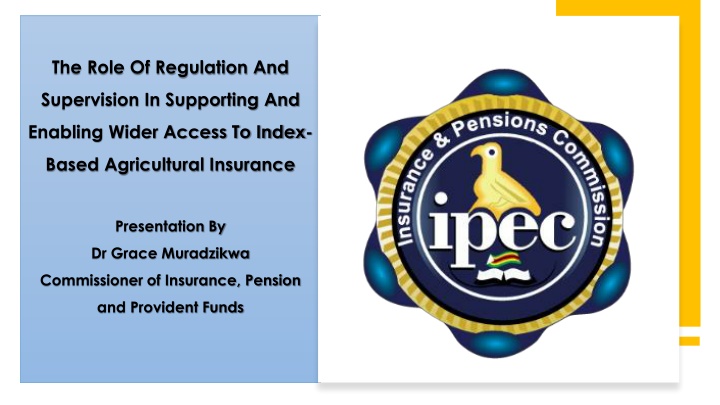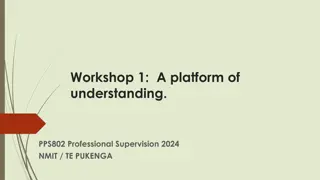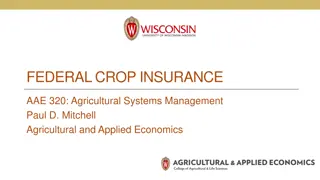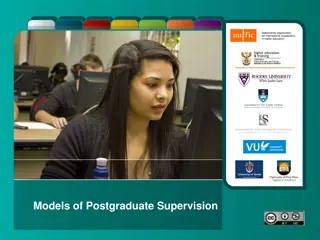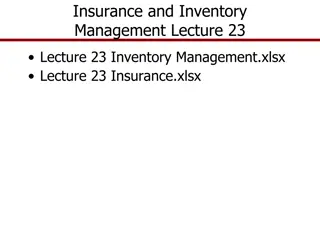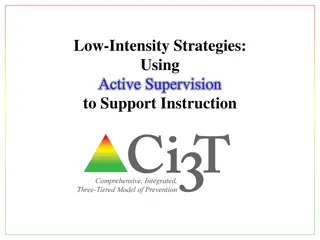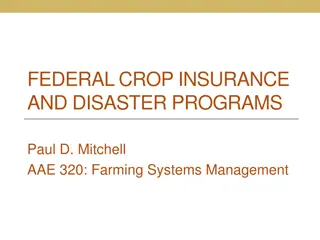Supporting Access to Agricultural Insurance Through Regulation and Supervision
Enhancing wider access to index-based agricultural insurance is crucial in Africa due to the significant risks faced in the agricultural sector. This presentation by Dr. Grace Muradzikwa, Commissioner of Insurance, Pension, and Provident Funds, highlights the role of regulation and supervision in addressing challenges and promoting best practices in agricultural insurance. The content covers the mandate of regulators, agricultural risks in Africa, challenges in agricultural insurance, lessons learned, index insurance practices, the Zimbabwe experience, and concluding remarks.
Download Presentation

Please find below an Image/Link to download the presentation.
The content on the website is provided AS IS for your information and personal use only. It may not be sold, licensed, or shared on other websites without obtaining consent from the author.If you encounter any issues during the download, it is possible that the publisher has removed the file from their server.
You are allowed to download the files provided on this website for personal or commercial use, subject to the condition that they are used lawfully. All files are the property of their respective owners.
The content on the website is provided AS IS for your information and personal use only. It may not be sold, licensed, or shared on other websites without obtaining consent from the author.
E N D
Presentation Transcript
The Role Of Regulation And Supervision In Supporting And Enabling Wider Access To Index- Based Agricultural Insurance Presentation By Dr Grace Muradzikwa Commissioner of Insurance, Pension and Provident Funds
Presentation Outline i. Mandate of the Regulator ii. Agricultural Risks In Africa iii. Challenges in Agricultural Insurance iv. Lessons From Africa v. Index Insurance Best Practices vi. Zimbabwe Experience vii. Conclusion
Mandate For The Regulator 03 04 05 01 02 IAIS Core Principles Principle 1- Safe, stable insurance market IAIS Core Principles Principle 1- Promote market development & financial stability Regulate & supervise for the protection of policyholders -Market vibrancy and sustainability Provide Policy Advisory to Governments Promote Financial Inclusion -Target insurance Penetration rate
In Africa, agricultural insurance often falls on stoney ground Economist, Dec 2018
Agricultural Risk In Africa - Natural disasters, such as floods and droughts, reduce agricultural investments, income, and economic growth - A moderate drought in Africa will reduce economic growth by 5% (ADB, et al 2019) - Agricultural insurance can mitigate impacts of natural disasters, yet its penetration is still low -Africa s share of global agricultural insurance is only 1% (Asia 42%, North America 40%, Europe 13%) GIZ, 2021 -Farmer s access to insurance is limited, index insurance can be more affordable and accessible, & expand insurance penetration -Insurance improves Governments fiscal planning to respond to disasters
Agricultural Risk In Africa Agricultural Premiums Collected (US$ Billions 2017 Prices) Region 2007 0.09 2017 0.3 Africa Asia Pacific 3.73 12.6 Europe 4.0 3.9 Latin America & Caribbean 0.77 12.0 North America 15.07 12.0 Total 23.6 30.0 Source: GIZ, 2021, Innovations and emerging trends in agricultural insurance for smallholder farmers an update
Challenges Of Index Insurance In Africa Lack of understanding of Index insurance among insurers, regulators and customers Absence of index-based specific insurance regulation in many jurisdictions. Third Party Involvement not supervised e.g. aggregators Lack of sufficient and reliable data for modelling of Index insurance products. Consumers are exposed to uninsured losses due to adverse basis risk. Resultantly, insurers suffer from operational and reputational risks.
Lessons from Other Markets Successes Agricultural Insurance Proper Functioning important factor in the sustainability and profitability of the agriculture sector. Government Involvement - Premium subsidy is a key component for the growth of agriculture insurance especially at inception. e.g. Kenya, Uganda, Costa Rica, Brazil, India, China Governments can play a role in promoting agri-insurance uptake by embedding it in their support programs, e.g., the case of the Zambia Farmer Input Support Program (FISP). Formation of Agriculture Insurance Pools - Agriculture insurance is better-provided through pools as climate risk is volatile and can affect many farmers simultaneously, leading to high loss ratios. Use of Technology -the integration of remote monitoring and digital solutions in insurance processes improves efficiency, translating into more affordable and accessible products Piloting - is key to gaining much needed experience before the full launch. Enabling Index Insurance Regulatory Environment - Specific regulations and/or frameworks to regulate Index insurance in countries with more developed index insurance landscape.
Index Insurance Best Practices for Regulators Provide Legal Regulatory Framework Product types, quality evaluation criteria, reserving methodologies and product approval process Index insurance contracts identified as valid insurance contracts Modelling - Structuring of Underlying Indices Use of multiple indices in same product Allow for innovation on use of indices Provide Consumer Protection Set and enforce product quality standards Regulator involvement in product design processes Setting and enforcing product quality standards Managing basis risk. This includes requiring insurers to identify fallback options for products and data. Collecting Data Regulators and Governments can help collect high quality data on agriculture Each insurer cannot install their weather stations Efficient Distribution Channels Acting through farmer aggregators, such as agricultural input providers, MFIs or public programs
Collaboration to Improve Agricultural Insurance Markets Consider scope of premium subsidies Tax exemptions waive VAT on inclusive insurance products More affordable products increase penetration and reduces risk Ministry of Finance and Economic Development Integrate agricultural insurance into risk management and agriculture extension services Train and implement good risk management to improve insurability of certain risks Ministry of Agriculture Maintaining reliable and representative weather data Validation of satellite data Meteorological Site Enabling a suitable environment for insurance pools Enabling easier access to reinsurance markets Government Banks, agribusiness, farmer organisations, microfinance and fintechs Distribution channels, role of consumer education and market conduct Distribution Channels
Zimbabwe Experience
Zimbabwe - Agro-based economy Zimbabwe s economy is an agro-based economy Most smallholder farmers on rain-fed agriculture exposed to climate risk Agriculture contributes about 11% of GDP & 30% of labour force. Sector source of livelihood to approx. 67% of the population Agriculture also contributes 60% of raw materials to the manufacturing industry. Nation endured 7 moderate to severe droughts between 1991-2020 Agriculture the penetration rate, its consumption of insurance services is minimal, contributing 9% to (GPW) in 2022. Strong initiatives to mitigate against climate risk present although still in its infancy
Effects of Climate Change on Economic Growth GDP and Agriculture Growth 2,500 25 20 2,000 15 Million Metric Tones 1,500 10 5 1,000 - 500 -5 - -10 2010 1,328 20 7 2011 1,452 14 1 2012 968 17 8 2013 799 2 -3 2014 1,456 2 23 2015 742 2 -5 2016 511 1 -4 2017 2,155 5 10 2018 1,831 5 18 2019 777 -6 -5 2020 927 -8 4 2021 1,800 8 17 Growth% Maize Output GDP Growth Agriculture Growth Maize Output GDP Growth Agriculture Growth
Challenges In Agricultural Insurance Limited awareness of agriculture insurance by small scale farmers. Lack of appetite by insurers to provide cover for agricultural risks. Few insurers in agriculture insurance space. The few insurers that provide cover to farmers offer limited cover. Few technical experts in the market focusing on agriculture insurance. Lack of reliable and accurate data (to enable product design and pricing)
Agriculture Index Insurance Project in Zimbabwe In line with our market development mandate Access to Insurance Initiative in partnership with InsuResilience and Reos Partners - Innovation Lab World Bank IFC, benchmarking tours with all relevant insurance stakeholders, Ministries of Agriculture and Finance Also includes an assessment to improve understanding of demand for index insurance, potential distribution channels, and factors limiting insurer appetite Current Status - IPEC developing a regulatory framework for regulating Agriculture Index Insurance. Market assessment is ongoing Government Reviewing Policy Concept Paper Industry Support in the development of inclusive insurance products
Conclusion The Insurance and Pensions Commission (IPEC) of Zimbabwe is looking forward to: Improved levels of insurance awareness and penetration. Development of innovative products by the insurance industry which are easy to understand, affordable, tailor-made, allow transparency, allow fast and fair loss settlement. Fair Treatment of customers Conducive regulatory environment. Collaboration among all stakeholders in the value chain.
References 1. German Agency for International Cooperation, (GIZ) 2021, Innovations and emerging trends in agricultural insurance for smallholder farmers an update, Deutsche Gesellschaft fur 2. African Development Bank, United Nations Environment Programme, United Nations Economic Commission for Africa, (2019) Climate Change Impacts on Africa s Economic Growth 3. Miranda M.J & Mulangu F. M. (2016) Index insurance for Agricultural Transformation in Africa, African Center for Economic Transformation, (ACET) & Japan International Cooperation Agency Research Institute (JICA) 4. Simones R. (2021) Index Insurance: 2020 Status and Regulatory Challenges, Access to Insurance Initiative 5. Insurance Association For Insurance Supervisors, (2019) Insurance Core Principles & Common Framework for Supervision of Internationally Active Insurance Groups, Updated November 2019
QUESTION & ANSWER SESSION Thank you
